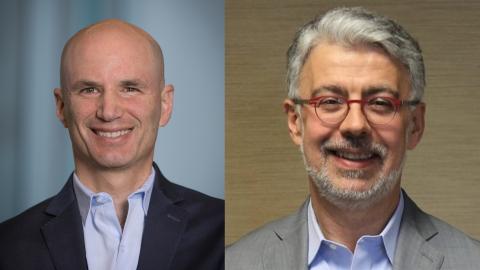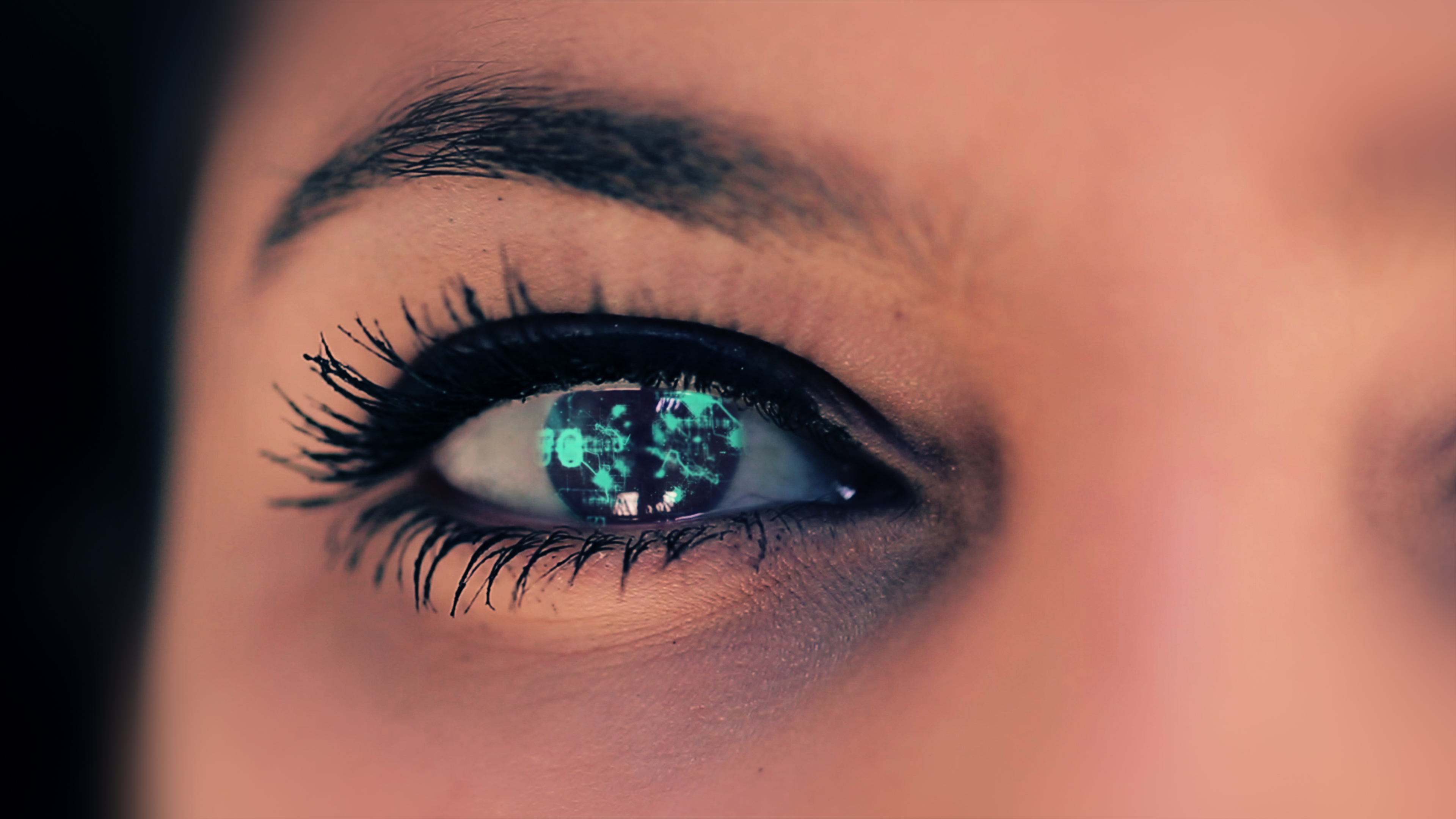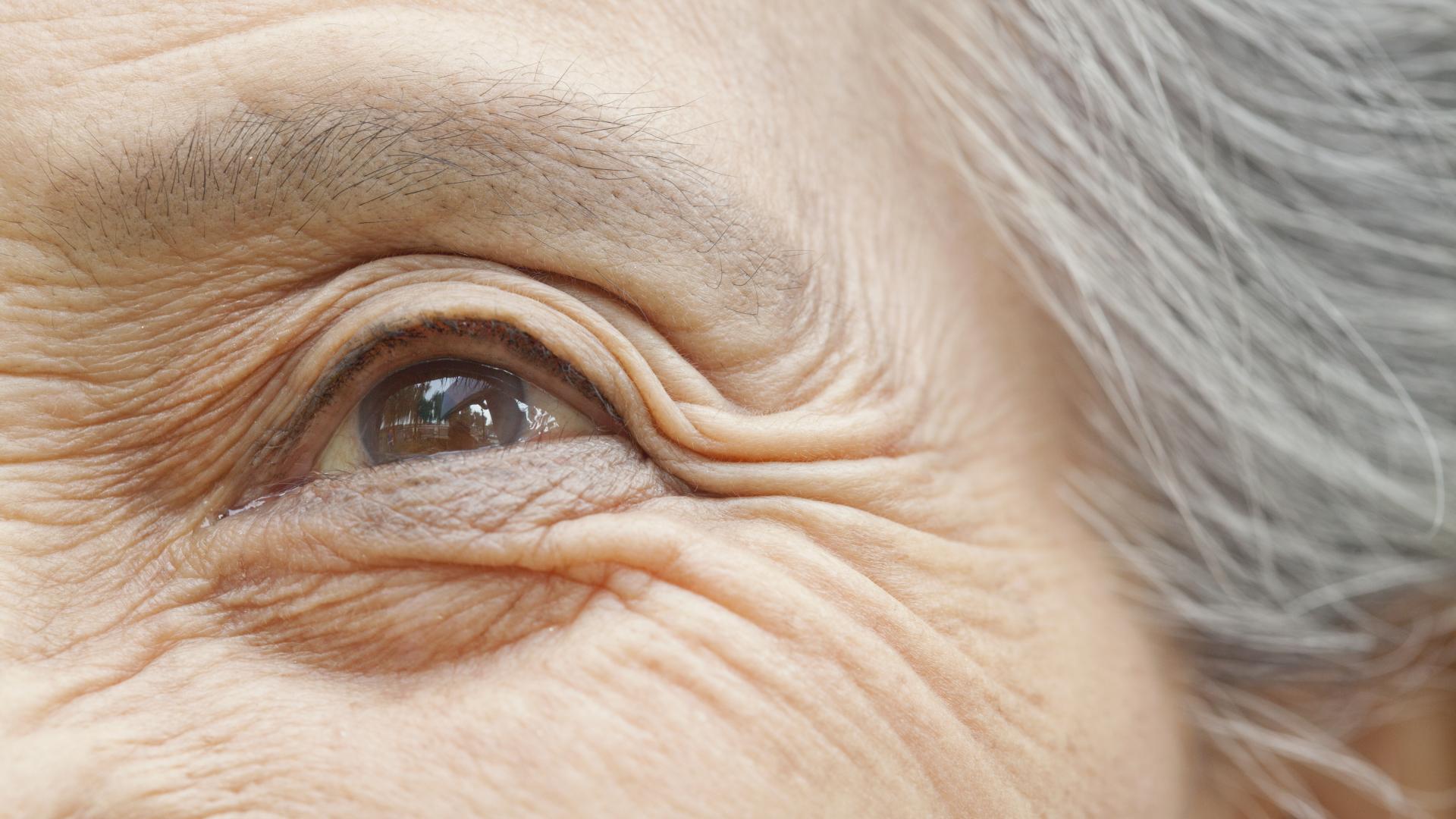MICHAEL BUCKLEY: Hello, I’m Michael Buckley with the BrightFocus Foundation, and welcome to today’s BrightFocus Chat, “Geographic Atrophy: A Possible New Treatment.” This is a really exciting time for vision research. Across AMD and other diseases, we’re seeing some really encouraging signs toward new and more effective treatments, and that’s what we’re going to talk about today.
If today is your first time on a BrightFocus Chat, welcome. The brief overview is that BrightFocus is funding some of the top scientists in the world that are trying to find cures and better treatments for macular degeneration, glaucoma, and Alzheimer’s. And we hold these Chats so you can learn what’s new in the field of research and in other aspects of caregiving and managing your vision health. We have a number of materials on our website at www.BrightFocus.org. So, today we have two special guests to tell us about some encouraging news in the field of geographic atrophy. The first is Dr. Moshe Vardi. He is with the Global Medicine team at Alexion Pharmaceuticals, which is based in Boston. And also from Alexion, we have Dr. Aleksandar Skuban, who directs their neurology and ophthalmology development program. So, Dr. Vardi and Dr. Skuban, welcome to today’s BrightFocus Chat.
DR. ALEKSANDAR SKUBAN: Thank you very much for having us. It is a pleasure to be here at this Chat.
MICHAEL BUCKLEY: There’s currently no treatment—no effective treatment—for the form of AMD known as geographic atrophy. I was wondering if you could just sort of set the table for us and explain the state of affairs right now, that why are there successful treatments for wet AMD, but up until this point, no effective treatment for the form known as geographic atrophy?
DR. MOSHE VARDI: It’s a pleasure to be here as well. I can start and then hand it over to Dr. Skuban. So, both of these diseases are indeed late-stage forms of AMD, but they are very distinct in the way that they develop. There are different mechanisms that drive these diseases, and therefore, different approaches on how to treat them. Wet AMD is primarily thought to be driven by destruction of blood vessels, while dry AMD—geographic atrophy—is primarily driven by an immune response, which is mediated by the complement system, and I know that we will talk about it later. So, different diseases, different perspectives on how to treat them. Now, we currently do have effective treatments for wet AMD. Those treatments are targeting inhibition of blood vessel formation and growth. That has proved to be very effective and has made a huge impact on patients’ lives and the way that this disease is managed. For dry AMD, this is not currently the state. This field is somewhat lagging, but the good news is that there are a lot of assets—new potential drugs—that are in active development.
MICHAEL BUCKLEY: I know you mentioned the complement system. Am I correct that that’s part of the immune system that’s involved in the disease? Because I think a lot of us are familiar with the immune system in terms of larger health. But is there that type of system in our vision health as well?
DR. MOSHE VARDI: You can think about the complement system as a first line of defense in our body and obviously in the eyes as well. It’s always active, and it is able to quickly respond to insults, meaning that if there is an identification of something that is wrong, the complement system kicks into play and pulls in the rest of the immune system. Now, what happens in diseases, such as geographic atrophy—actually, such as AMD—is that this complement system is going out of control. It is working more than it needs to work, and this is the source of the pathology in AMD.
MICHAEL BUCKLEY: In your work on geographic atrophy, how did you come to identify this complement system as a possible path to an effective treatment?
DR. MOSHE VARDI: The complement system is well known to be the driver of AMD. It might not be the only driver, but it’s definitely front and center. There are clues coming out of genetic analysis. There are genes that are impacted, which are driving complement protein development. So, we know that in AMD patients, these genes tend to be affected more than in the general population. There is also work that looks at tissues from diseased eyes and have shown a lot of complement deposition, meaning that there is more complement than we expect to be in those affected eyes. And then, lately, we are learning from clinical studies that intervention at the complement system level, meaning that when we inhibit the complement system, which is hyper-reactive, we actually get good outcomes. So, there is more and more evidence accumulating that the complement plays a significant role in the development of the disease and trying to inhibit the complement system may actually play out as a very good strategy.
MICHAEL BUCKLEY: That’s interesting. And I think our listeners, we’ve all become much more aware in the past year or so about clinical trials as we’ve followed the efforts to develop and rollout COVID vaccines, but I was wondering if you could tell us a little bit about how clinical trials work in vision? And specifically, I understand you have a product in development called danicopan. I was wondering how the clinical trial process got started toward this possible new treatment for geographic atrophy.
DR. ALEKSANDAR SKUBAN: We have a product, as you mentioned, danicopan, which we have identified as being a good candidate to influence the later progression of geographic atrophy. As you alluded to, the clinical trial development—or the clinical development—process is quite a complex and rigorous one, and it builds on the scientific evidence on preclinical evidence and testing in different animal species but also building on the information that is available in the literature. Over the last year—year and a half—we have engaged with multiple scientific stakeholders, with regulatory agencies, with experts with this compound, which we believe is very well positioned to affect the geographic atrophy in slowing the progression because of its unique properties. We have built a clinical program, and we have started with a phase 2 clinical program—so, a proof-of-concept study—that will be looking into assessment of how danicopan works in geographic atrophy. More specifically, this study is designed to study the efficacy and the safety in patients with GA, and we are looking forward to learn more about the effects of this specific mechanism of action in patients with late AMD. All in all, we are, I believe, at the beginning of a very exciting scientific clinical journey, and we are taking this process in a very rigorous and stepwise manner.
MICHAEL BUCKLEY: To our listeners, we will provide, free of charge, a transcript of today’s call. You can get that simply by leaving your name and U.S. mail address at the end of the Chat. But for people taking notes right now, the medicine, danicopan, is spelled D as in David, D-A-N-I-C-O-P-A-N—danicopan, capital D, A-N-I-C-O-P-A-N. And I was wondering, we’re all familiar with the COVID vaccine process. Is this something that also goes through the FDA—the Food and Drug Administration? Do they set the ground rules for how a vision clinical trial would work?
DR. ALEKSANDAR SKUBAN: Absolutely, yes. The clinical development process is highly regulated. It is overseen by FDA. And, in fact, the major clinical and preclinical steps of decision making are always done in consultation with regulatory agents, and in this case, FDA. So, the answer is absolutely yes.
MICHAEL BUCKLEY: Related to that, sometimes we hear about an existing approved medicine that gets used … exploratory use in a new area. Is danicopan something that currently exists for use in other diseases, or is this something … a new compound that’s being developed?
DR. MOSHE VARDI: Danicopan is still in development, meaning that this is not available as a commercial drug for any other indication. It is developed in other indications, not just in geographic atrophy. These diseases that are driven by complement—primarily a section of the complement system, which is called the alternative pathway—are more susceptible to treatment with medications, such as danicopan. So, in short, yes. A few examples. We do have a program in a disease called paroxysmal nocturnal hematuria—this is a hematological disease. And we also have a collaboration with the NIH in COVID-19 patients. So, a lot is going on, and that actually means that we are generating more safety data than you would expect for a program that is limited to just one disease area, which is overall, good.
MICHAEL BUCKLEY: What do you think if—your best-case scenario—what would danicopan do to actually protect or help an eye that has … help a person that has macular degeneration, specifically geographic atrophy? What would it … in lay person’s terms, what would it do to help that person?
DR. ALEKSANDAR SKUBAN: Our hypothesis is—and the hypothesis on which the proof of concept that the phase 2 clinical trial has been built—is that the design of the study, as it is now, is looking into whether this investigational drug—whether danicopan treats and slows the progression of GA—slows the progression of the area of the growth of geographic atrophy over time, and that it’s safe and effective to use in the population. That is the main goal of the phase 2 study.
MICHAEL BUCKLEY: To the two of you, if this medicine becomes used in patient care, how is it delivered? Is it an injection? Is it a pill? How would this work?
DR. ALEKSANDAR SKUBAN: This is an oral treatment, so this is a pill—or actually a tablet—that would be administered orally. And that is a different way of administering potential new treatments in geographic atrophy, compared to what the current clinical trial landscape is providing as options for the patient. So, it could be delivered systematically, and it would specifically have an effect in the patient’s eyes and have the ability to treat both patient’s eyes at the same time.
MICHAEL BUCKLEY: That’s really interesting because we’ve … as you can imagine, probably the number one question that we get at the BrightFocus Chats is about injections and the burden that that takes. And so, this is really exciting to see a different route. So, it’s interesting that you say that it could help both eyes. Are there any potential adverse effects that you’re keeping a lookout for throughout this clinical trial process?
DR. ALEKSANDAR SKUBAN: Absolutely, yes. So, if you allow for a moment just for your audience to put the adverse event definition in focus, the adverse event—as we refer to it in the clinical development process—means any untoward medical occurrence during the clinical trial process while the pharmaceutical agent is administered, right, regardless of the fact of whether there is a causal relationship with the treatment. So, as with any therapeutic intervention, the adverse events are possible. Whether some people are more likely to have side effects is challenging to predict. However, we are very carefully and very systematically inquiring and collecting and analyzing all the possible side effects for any therapeutic treatment or any drug that we are testing in clinics.
MICHAEL BUCKLEY: You mentioned the kind of monitoring for safety in a clinical trial, are those people taken out of the system if they start showing any adverse indications?
DR. ALEKSANDAR SKUBAN: Adverse events may be … again, anything that the patient experiences during participation in clinical trials, and that is whether there is an assessment of whether that untoward event is related or nonrelated to the treatment, which is something that the principal investigator or the investigative physician usually assesses. Not all adverse events lead to discontinuation. Some do, and that is the decision that primarily the physicians that are running the clinical trials do, but there are many different scenarios. So, not necessarily an adverse [inaudible] that is experienced would lead to a drug being stopped. But then, again, it is a very rigorous process in which the patient and the physician are having this conversation.
MICHAEL BUCKLEY: For the two of you, we’ve got a few listeners wondering if you could explain the terminology of a phase 2 trial or a phase 3 trial. Again, we’ve heard these phrases in the news media over the last year, but they don’t always explain what that is. So, could you talk about that—the phases in terms of what a 2 and a 3 is, and where danicopan is in that process?
DR. MOSHE VARDI: There’s actually a very robust process in order to develop new drugs and to get them to patients, and that includes different phases. We were asked about phase 2/3. Maybe I’ll start with phase 1. Phase 1 is where you actually test drugs on primarily healthy volunteers to understand the initial safety, as well as some pharmacological-related attributes of the drug. To the question: What is phase 2? Phase 2 is where you treat patients with the disease that you’re actually targeting in terms of bringing the medication to treat that disease, but the focus of the phase 2 study is to generate proof of concept, to find the right dose, and primarily to look into the safety of the asset in the particular population—meaning, in this case, geographic atrophy patients. And this is the stage in which danicopan is currently in for geographic atrophy. We are currently running a phase 2 study to assess the effect of danicopan in geographic atrophy patients, meaning that the focus is whether or not it has an effect, what is the right dose, and are there any safety concerns? The Phase 3 studies are confirmatory studies with … again, focused on efficacy and safety, and they will serve as the bigger data source in order for regulators, such as the FDA, to assess the balance between effectiveness and safety and then to decide whether they are granting approval for the drug or not. This is, as Aleks said earlier, a very rigorous process, and it’s governed by the FDA, which is obviously governed by rules and regulations. So, again, a very robust and lengthy process.
MICHAEL BUCKLEY: Do you have a best-case scenario? How long do you think this process will take before … again, best-case scenario, the trials go great. The FDA approves it for use, but do you have a sense of how long that would be down the road?
DR. MOSHE VARDI: I can speak in general terms. It usually takes up to 7 to up to 10 years to take a drug from phase 1 all the way through approval. It’s a very long process. The good news is that there are other companies with other complement inhibitors that are further along in the process, and hopefully, those assets will be available to patients sooner than danicopan.
MICHAEL BUCKLEY: And so, these clinical trials for danicopan, what countries are those taking place in?
DR. ALEKSANDAR SKUBAN: This is a truly a global clinical trial. It takes place in North America, in the U.S., and Canada, in a number of countries in Europe, and also Asia as well. And we are looking to conduct a trial in Australia and New Zealand. So, truly a global reach for danicopan in phase 2.
MICHAEL BUCKLEY: Give us a sense of how many sites you’d have or are they throughout the country or in certain regions here in the U.S.?
DR. ALEKSANDAR SKUBAN: We are in the process of starting up many of the sites in the U.S. An approximate number of sites that we are planning to activate in the U.S. would be around 40, and in Canada, in single digits. This number may change, but it may give you a sense of the breadth of the involvement of the U.S.
MICHAEL BUCKLEY: It’s a great magnitude. What type of person would be eligible to participate in a danicopan clinical trial?
DR. ALEKSANDAR SKUBAN: The protocol does have a very specific inclusion/exclusion criteria, if this is what you meant, and patients who are interested and who … whose physician is determining based on the number of eligibility criteria that they may participate in the clinical trial would undergo an informed consent process in which they would be informed about all aspects of the clinical trial and to the screening process in which their eligibility would be confirmed. And if they qualify, they would be starting the treatment with danicopan, with the assigned treatment to be completely precise because this is a double-masked study in this phase 2 trial. So, in essence, there is a number of predefined—both ophthalmological and medical—criteria, which the patient interested in this trial would need to be completing in order to be qualified.
MICHAEL BUCKLEY: I know we get questions from a listener who sometimes … they’ll have one form of AMD in one eye and a different stage of AMD in another. Is that … when you mention criteria, would that be a factor of whether they have geographic atrophy in one eye or both? When you mention some of the eligible criteria, is something like that part of the factors?
DR. ALEKSANDAR SKUBAN: Yes. Obviously, the presence of a qualifying geographic atrophy change in one eye that conforms to the inclusion criteria would be sufficient for the patient to qualify. There does not need to be presence in both eyes.
MICHAEL BUCKLEY: Thank you. That’s good to know. How would somebody that’s interested in participating in the upcoming trial of danicopan … how would they go about learning more? I have your company’s website and phone number I can give out. Or is this something they can ask their doctor? What would you recommend for next steps?
DR. ALEKSANDAR SKUBAN: We are truly fortunate to be able to share this information with your audience today that we are conducting this clinical study. As a matter of general overview of the opportunities, I believe that—that the patient’s physician, ophthalmologist, retinal specialist may be an excellent resource to identify new clinical research. This study is listed on the ClinicalTrials.gov website, and I would like to add that our team is diligently working on a study-specific website that will contain more specific study information. This is not yet available—we expect it within the next few months, but I hope that any of the above-mentioned resources until that time will be sufficient to identify not only the study but the potential clinical investigative site that may be the closest to the patient who is interested in participating.
MICHAEL BUCKLEY: In the few minutes we have left, we have a couple of questions from the listeners about danicopan. A couple of people are wondering: Do you anticipate this being able to work for wet AMD, or do you think that you see this more exclusively for geographic atrophy in the form of dry AMD?
DR. MOSHE VARDI: We are testing danicopan for geographic atrophy. This is where the science leads us, meaning that there is no proof that complement dysregulation is involved with the development of dry AMD. This is not to say that wet AMD is not a potential next step for us. There is some proof to say that complement is a part of the dysregulation in wet AMD, as well, but that needs further assessment in scientific research. The thing that was mentioned earlier about the two eyes and only one eye meeting the criteria to be included in the study is very important because, at the end of the day, the drug will work on both eyes even though, in some cases, only one eye will qualify for the study. So, we do expect to have patients with dry AMD in the qualifying eye and potentially wet AMD in the other eye, so we will generate data that would be very interesting for us and also for the scientific community to see how a systemic complement inhibitor in this case may affect wet AMD. So, more to come, but this is very early and, again, premature.
MICHAEL BUCKLEY: Sure. And again, another question that might be premature, but a few listeners have asked today: Would danicopan potentially reverse vision damage that’s already occurred, or is this more stopping-the-progression-getting-worse best-case scenario?
DR. MOSHE VARDI: Unfortunately, geographic atrophy is a progressive, degenerative disease, meaning that the cells that are affected and are dead would not be able to come back to life. So, the concept of complementing inhibition in geographic atrophy is really to slow or even halt progression, hopefully, but it will not be able to reverse the damage that was already done.
MICHAEL BUCKLEY: I appreciate that. And one final question before we start to wrap up. A number of our listeners help support BrightFocus research in areas, such as macular degeneration, and one of the research we support is more early-stage research, but I was wondering if you can give an explanation of how some of that early-stage—some people call it basic research—how does some of that progress or roll up into a drug development process that you’re in right now? I was just wondering if you could explain how that progression works?
DR. MOSHE VARDI: I want to take the opportunity to thank BrightFocus for their investment in areas that are … in which so much unmet need exists. This is truly important. Nothing happens without science in the space that we work in, and as I said earlier, science is the true driver of everything that we do. In order for us to think that danicopan could work in geographic atrophy, we had to rely on a lot of science that was generated by organizations, such as BrightFocus. So, extremely important, science is where concepts and being tested, hypotheses are being generated, and then we—in the drug development space—take these ideas and move them forward through the lengthy process of clinical scientific research. But basic science is where it all starts.
MICHAEL BUCKLEY: It really sounds like the building blocks for some of these exciting developments we’ve been talking about today and in other recent BrightFocus Chats. Dr. Vardi and Dr. Skuban, this has been really exciting to hear some encouraging signs of progress for geographic atrophy, knowing that right now there’s no … currently no effective treatment. Before we conclude, do you have any last thoughts you’d like to share with our listeners about the scientific process or your overall sense of the field of vision science?
DR. MOSHE VARDI: I’d like to thank you for the opportunity to be in front of this audience. This is a huge honor for us at Alexion. I also want to say to all of you who are listening and thinking about geographic atrophy: Yes, there are no current available treatments, but there is a lot going on in terms of research, in terms of development, and we are very hopeful that in the near to intermediate future, there will be something out there for the treatment of GA. So, we are very lucky to be a part of this training, and we are all working very hard toward a goal, which I think will serve geographic atrophy patients in the best way. So, thank you for that.
MICHAEL BUCKLEY: Our pleasure. Dr. Skuban?
DR. ALEKSANDAR SKUBAN: I would just like to second Moshe’s words. It has been a true honor for us being here today and sharing some of our work in this very complex area, a very promising and, hopefully, a very fruitful field in which we can expect effective treatment in the not-so-distant future. We are really happy to have been able to share some of that today.
MICHAEL BUCKLEY: The field of vision science just really offers us so much hope for the future. So, on behalf of BrightFocus and Dr. Vardi and Dr. Skuban, I’d just like to thank our listeners for joining. We hope you found this really helpful and also hopeful about where we’re going in terms of better treating age-related macular degeneration. So, on behalf of BrightFocus, this concludes today’s BrightFocus Chat, and thank you so much for being a part of it. Bye-bye.










